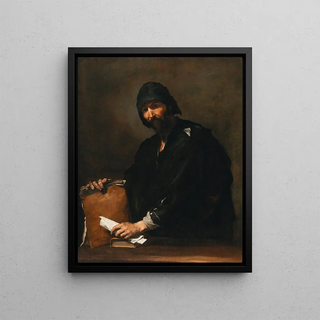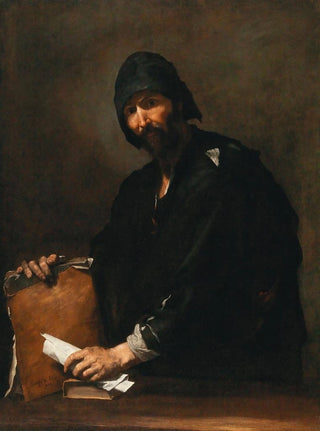Art print | Heraclitus - Jusepe de Ribera


View from behind

Frame (optional)
In the fascinating universe of baroque art, the artwork "Heraclitus" by Jusepe de Ribera stands out for its dramatic intensity and psychological depth. This painting, depicting the renowned Greek philosopher immersed in a contemplative melancholy, invites us to explore the duality of human existence. The art print Heraclitus - Jusepe de Ribera, while preserving the essence of the original, takes us on a journey through time, revealing existential questions that have transcended ages. Light and shadow, emblematic elements of the baroque, intertwine to create an atmosphere filled with mystery and reflection.
Style and uniqueness of the work
Ribera's style is characterized by an exceptional mastery of chiaroscuro, a technique that emphasizes the volumes and emotions of the characters. In "Heraclitus," the light illuminates the philosopher's face, highlighting his features marked by wisdom and suffering. The choice of colors, dominated by dark and earthy tones, reinforces the idea of melancholy and solitude. Heraclitus's posture, with his head bowed and gaze lost in the void, evokes deep introspection—a silent dialogue between man and the universe. This work does not merely depict a historical figure; it embodies a philosophy, that of a thinker questioning the nature of the world and humanity.
The artist and his influence
Jusepe de Ribera, born in Spain and having built his career in Italy, is one of the masters of the baroque. His work is marked by a constant search for truth and emotion, often through portraits of historical or mythological figures. Influenced by Caravaggio, Ribera develops a personal style that combines realism and expressiveness. His impact on Spanish and European art is undeniable, inspiring many artists to explore similar themes. The depiction of Heraclitus fits within this desire to capture the complexity of the human soul, making Ribera a pioneer in exploring inner emotions. His legacy endures, testifying to the power of art in

Matte finish

View from behind

Frame (optional)
In the fascinating universe of baroque art, the artwork "Heraclitus" by Jusepe de Ribera stands out for its dramatic intensity and psychological depth. This painting, depicting the renowned Greek philosopher immersed in a contemplative melancholy, invites us to explore the duality of human existence. The art print Heraclitus - Jusepe de Ribera, while preserving the essence of the original, takes us on a journey through time, revealing existential questions that have transcended ages. Light and shadow, emblematic elements of the baroque, intertwine to create an atmosphere filled with mystery and reflection.
Style and uniqueness of the work
Ribera's style is characterized by an exceptional mastery of chiaroscuro, a technique that emphasizes the volumes and emotions of the characters. In "Heraclitus," the light illuminates the philosopher's face, highlighting his features marked by wisdom and suffering. The choice of colors, dominated by dark and earthy tones, reinforces the idea of melancholy and solitude. Heraclitus's posture, with his head bowed and gaze lost in the void, evokes deep introspection—a silent dialogue between man and the universe. This work does not merely depict a historical figure; it embodies a philosophy, that of a thinker questioning the nature of the world and humanity.
The artist and his influence
Jusepe de Ribera, born in Spain and having built his career in Italy, is one of the masters of the baroque. His work is marked by a constant search for truth and emotion, often through portraits of historical or mythological figures. Influenced by Caravaggio, Ribera develops a personal style that combines realism and expressiveness. His impact on Spanish and European art is undeniable, inspiring many artists to explore similar themes. The depiction of Heraclitus fits within this desire to capture the complexity of the human soul, making Ribera a pioneer in exploring inner emotions. His legacy endures, testifying to the power of art in






